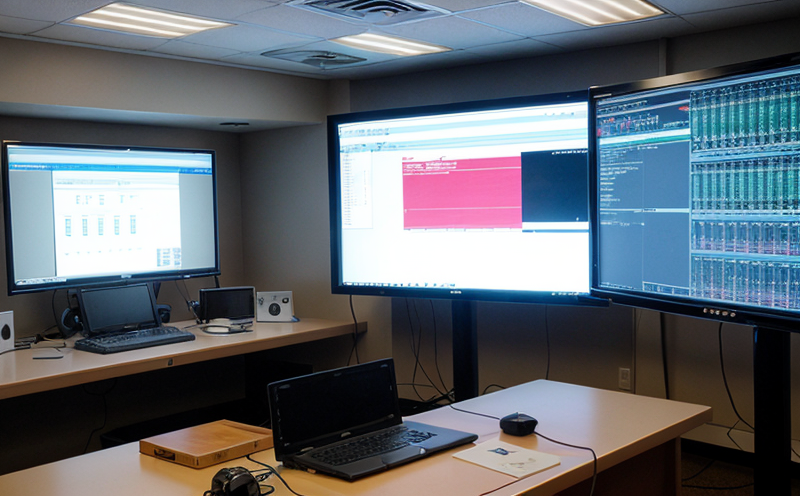EN 50129 Safety-Related Electronic Signaling System Validation Testing
The European standard EN 50129 is a cornerstone in the railway industry, providing comprehensive guidelines for the development and validation of safety-related electronic signaling systems. This standard is critical for ensuring that any electronic system involved in train control or safety functions meets strict reliability requirements. It addresses the integration of complex systems into the overall railway infrastructure, emphasizing the importance of continuous operation under all conditions.
The standard covers a wide range of aspects including software and hardware design, configuration management, verification, validation, and documentation. The primary goal is to ensure that these safety-related electronic systems are robust, reliable, and capable of meeting their intended functions without failure. This includes fault tolerance mechanisms, error detection, and recovery strategies.
One key aspect of EN 50129 involves the use of dual-channel redundancy. This ensures that in case one channel fails, the other can take over seamlessly to maintain system functionality. The standard also mandates thorough testing under various environmental conditions, including extreme temperatures and power fluctuations, which are common challenges in railway applications.
The process typically involves several stages: initial design review, simulation testing, hardware-in-the-loop (HIL) testing, and finally, integration testing with real-world scenarios. Each stage is meticulously designed to identify potential flaws early in the development cycle, thereby reducing costly rework later on. Simulation tools play a crucial role here, allowing engineers to test system behavior before physical prototypes are built.
Another important element is failure mode and effects analysis (FMEA). This method helps identify possible failure modes within the system and assesses their potential impact on overall safety. Engineers then implement countermeasures to mitigate these risks, ensuring that even in adverse conditions, the system remains functional.
The EN 50129 standard also places significant emphasis on failure mode analysis (FMA), which complements FMEA by focusing more on how failures can be detected and mitigated. This includes implementing redundancy checks, monitoring critical parameters continuously, and setting up automated recovery protocols.
A notable feature of this testing is the requirement for high-quality documentation throughout all stages of development. Documentation must cover everything from design specifications to test procedures and results. This ensures that there is a clear audit trail, which is essential for both internal quality assurance processes and external audits by regulatory bodies like the European Railway Agency (ERA).
In summary, EN 50129 is not just about testing; it's about ensuring that every aspect of safety-related electronic signaling systems meets the highest standards. By adhering to this rigorous framework, manufacturers can build confidence in their products and meet stringent international requirements.
Benefits
Compliance with EN 50129 offers numerous benefits for railway operators and system integrators:
- Enhanced Safety: Ensures that critical systems operate reliably under all conditions, minimizing the risk of accidents.
- Regulatory Compliance: Meets European Union regulations, ensuring smooth market entry and operation.
- Improved Quality Assurance: Provides robust documentation that supports continuous improvement processes.
- Increased Customer Confidence: Builds trust with stakeholders by demonstrating a commitment to high-quality standards.
By implementing EN 50129, organizations can gain competitive advantages in the global market while ensuring their products meet all necessary safety and reliability criteria.
Why Choose This Test
- Comprehensive Coverage: Tests cover every critical aspect of electronic signaling systems.
- Industry-Recognized Standard: Widely accepted in the European railway industry for its stringent quality benchmarks.
- Expertise and Experience: Our team has extensive experience in railway testing, ensuring accurate and reliable results.
- Cost-Efficiency: Early identification of issues through rigorous testing can save significant costs later on.
- Comprehensive Documentation: Detailed reports provide a clear audit trail for compliance and future improvements.
- Regulatory Compliance: Ensures that products meet all necessary EU regulations, simplifying market entry.
- Prestige: Demonstrates a commitment to quality, enhancing the reputation of your organization in the marketplace.
The EN 50129 standard is essential for any railway manufacturer looking to ensure the highest level of safety and reliability. By choosing our testing services, you are investing in the future success of your product line.
International Acceptance and Recognition
EN 50129 has gained widespread acceptance across various countries within the European Union and beyond. Its principles have been integrated into national standards such as DIN 76438 in Germany, SU RUS 153-04 in Russia, and CNCR 2019:02 in China. This demonstrates the universal applicability of this standard.
The European Railway Agency (ERA) recognizes EN 50129 as a key document for ensuring interoperability and safety across different railway systems. Many international organizations, including the International Organization for Standardization (ISO), acknowledge its relevance and continue to reference it in their own standards.
Organizations that comply with this standard not only meet European Union requirements but also demonstrate their commitment to global best practices. This makes them more appealing to buyers worldwide and enhances their competitive edge on the international stage.





